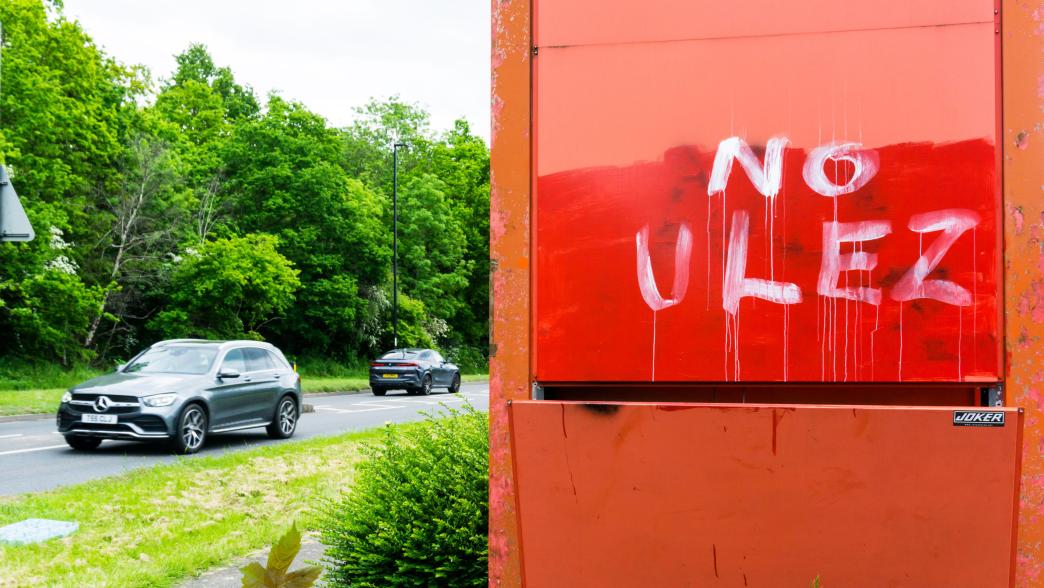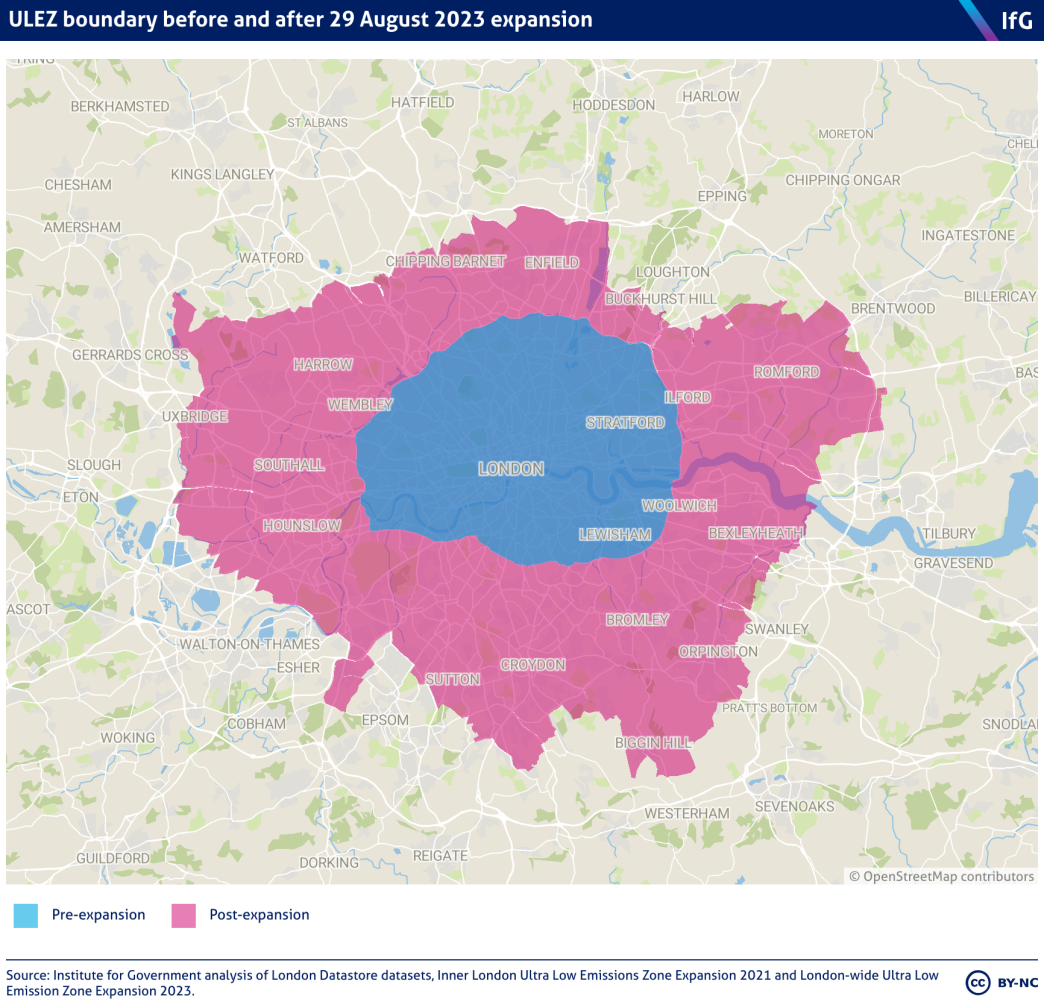ULEZ and its expansion
What is London's Ultra Low Emissions Zone, and why has its expansion caused such controversy?

The Ultra Low Emission Zone is an area within London in which a £12.50 daily charge is levied on people driving vehicles that do not comply with ULEZ emission standards. Most petrol vehicles under 16 years old and diesel vehicles under six years old should meet these standards. It applies 24 hours a day, every day, with the sole exception of Christmas Day.
ULEZ was first introduced in April 2019 as a means to improve air quality in the capital, though applied to a smaller area in inner London. Its expansion in 29 August 2023 to cover all London boroughs prompted backlash from motorists in outer London, and manifested as a key campaign issue in the Uxbridge and South Ruislip by-election. The expansion was also subject to an unsuccessful High Court challenge, in which it was ultimately ruled as lawful.
Why has ULEZ become the subject of political debate?
How did ULEZ change?
Prior to the expansion all areas within the North and South Circular Roads were within the ULEZ, but many outer London boroughs were unaffected.
As of 29 August all 32 London boroughs are included, roughly equivalent to the area within the M25 motorway.

When was ULEZ first introduced, and how has it been expanded?
The original ULEZ was announced in 2013 by the then mayor of London Boris Johnson, with the hope it would operational by 2020. 60 BBC, ‘Boris Johnson announces plans for Ultra Low Emission Zone’, 13 February 2013, retrieved 01 September 2023, https://www.bbc.co.uk/news/uk-england-london-21443439 This fell outside Johnson’s term and, at the time, he had not declared if he would run for a third term. 61 [1] Siddique H, ‘Boris Johnson considering third term as mayor of London’, 02 July 2013, retrieved 01 September 2023, https://www.theguardian.com/politics/2013/jul/02/boris-johnson-third-term-london-mayor It was however implemented by his successor, Sadiq Khan, in April 2019, originally covering the same central London area as the congestion charge. 62 Mayor of London Office, ‘Mayor plans to introduce Ultra Low Emission Zone in April 2019’, 04 April 2017, retrieved 01 September https://www.london.gov.uk/press-releases/mayoral/mayor-plans-to-introduce-ulez-in-april-2019 Khan’s initial ULEZ proposal also included plans to expand the area up to and including the North and South Circular Roads sometime between 2019 to 2021. 63 Moran M, ‘Mayor of London brings launch of Ultra-Low Emission Zone forward’, 10 October 2016, retrieved 01 September, https://www.transportxtra.com/publications/local-transport-today/news/50275/mayor-of-london-brings-launch-of-ultra-low-emission-zone-forward/
In May 2020, during the height of the pandemic, then transport secretary Grant Shapps wrote a letter to Khan setting out the terms of funding package to support Transport for London (TfL). This included the request to urgently bring forward proposals to widen the scope of the ULEZ, LEZ and the Congestion Charge. 64 Mayor of London Office, ‘FOI – Communications with Grant Shapps [Oct 2022]’, (no date) retrieved 01 September, https://www.london.gov.uk/who-we-are/governance-and-spending/sharing-our-information/foi-disclosure-log/foi-communications-grant-shapps-oct-2022 However, before Shapps’ letter, the date of the first expansion had already been set for October 2021. 65 Mayor of London Office, ‘Mayor: Ultra-Low Emission Zone to expand up to North & South Circular’, 08 June 2018, retrieved 01 September, https://www.london.gov.uk/press-releases/mayoral/ultra-low-emission-zone-to-expand
Can the UK central government block the plans?
Based on current devolved powers, it is within the mayor of London’s authority to expand ULEZ. The Greater London Authority Act 1999 grants the mayor the power to introduce road user charges and since 2003 successive mayors have done so. 66 Tyes R and Smith L, ‘Clean Air Zones, Low Emission Zones and the London ULEZ’, House of Commons Library, 11 August 2023, retrieved 01 September, https://commonslibrary.parliament.uk/research-briefings/cbp-9816/ There is a clause under the Act that the government can reject the mayor’s transport strategy if it is “inconsistent with national policies relating to transport”. 67 Greater London Authority Act 1999, part 5, section 143 However, though Rishi Sunak has voiced his criticism of the ULEZ expansion, it has been reported the government has dropped plans to block the expansion based on legal advice this would be overturned if challenged in court. 68 Riley Smith B, Gutteridge N and Knapton S, ‘Sunak blocked from overruling ‘nightmare’ Ulex expansion’, Telegraph, 22 August 2023, retrieved 01 September, https://www.telegraph.co.uk/politics/2023/08/22/rishi-sunak-blocked-overruling-ulez-expansion-london/
How many people will pay the ULEZ charge after the expansion?
TfL claims that over 90% of cars driving in outer London already met the ULEZ standards and will not have to take action. 75 Transport for London ‘Over 90 per cent of cars driving in outer London now meet the ULEZ standards’, 23 March 2023, retrieved 01 September 2023, https://tfl.gov.uk/info-for/media/press-releases/2023/march/over-90-per-cent-of-cars-driving-in-outer-london-now-meet-the-ulez-standards
According to an FoI request by the RAC prior to the expansion there were nearly 700,000 cars in Greater London that would be liable to pay the charge, rising to over 850,000 when counting all non-complaint vehicles (for example vans). 76 RAC, ‘Drivers of nearly 700,000 cars in Greater London could be liable to pay the ULEZ charge when the zone is expanded this summer’, 24 March 2023, retrieved 01 September 2023, https://www.rac.co.uk/drive/news/motoring-news/drivers-greater-london-could-be-liable-to-pay-the-ULEZ-this-summer/ The London mayor's office have disputed these claims, arguing the number of registered non-compliant vehicles may include those that are rarely or never used. In 2022 TfL estimated there were around 160,000 non-compliant ULEZ cars driving in outer London. 77 Transport for London, ‘TfL seeks views on expanding world-leading ULEZ London-wide, as new data estimates it would deter more than 100,000 of the most polluting cars a day’ 20 May 2022, retrieved 01 September, https://tfl.gov.uk/info-for/media/press-releases/2022/may/tfl-seeks-views-on-expanding-world-leading-ulez-london-wide
How effective is the policy at improving air quality?
There is a large body of research to show that low emission zones (LEZs) in general reduce air pollution and can improve public health.
78
Fuller G, Low emission zones are improving health, studies show, The Guardian, 30 June 2023, retrieved 01 September, https://www.theguardian.com/environment/2023/jun/30/low-emission-zones-lez-improving-health-studies
In a press release the mayor’s office states that the expansion of the ULEZ should “further progress to reduce air pollution, by reducing nitrogen oxides (NOx) emissions from cars and vans in outer London by 10% and 7% respectively, and reducing PM2.5 car exhaust emissions in outer London by nearly 16%, benefitting five million outer London residents”.
79
Mayor of London Office, ‘Ultra Low Emission Zone will be expanded London-wide’, 25 November 2022, retrieved 01 September, https://www.london.gov.uk/ultra-low-emission-zone-will-be-expanded-london-wide
[1] https://iopscience.iop.org/article/10.1088/1748-9326/ac30c1
Of the research examining the impact of the ULEZ policy so far, studies have ranged in their assessment. A 2019 study on the initial impact of the original inner London zone found widespread but marginal reductions in levels of pollution. 80 Ma L, Graham D J, Stettler M E J, ‘Has the ultra low emission zone in London improved air quality?’ Environmental Research, 2021, 16(12), p.124001 Another found that in the first year of operation levels of nitrogen oxides within the zone were reduced by 20% while in Greater London there was a reduction of 15%.
What other low emission zones are there?
In 1996 Sweden was the first country to implement zones that sought to limit vehicle access with the explicit purpose of reducing the particle pollution or particulate matter (PM) known to be harmful to people’s health. 91 Amundsen A H and Sundvor I, ‘Low Emission Zones in Europe’, Institute of Transport Economics Norwegian Centre for Transport Research, 01 October 2018, retrieved 01 September, https://www.toi.no/getfile.php?mmfileid=49204 Low emission zones have been introduced across Europe, with 320 active in 2022. 92 CleanCities, ‘The development trends of low and zero-emission zones in Europe’, 20 July 2022, retrieved 01 September 2023, https://cleancitiescampaign.org/wp-content/uploads/2022/07/The-development-trends-of-low-emission-and-zero-emission-zones-in-Europe-1.pdf
The first LEZ in the UK was introduced in London in 2008. (In 2003 the London Congestion Charge was rolled out within the London Inner Ring Road, but was only designed to reduce traffic.) It currently follows the same boundaries as the expanded ULEZ area but only applies to large, commercially operated diesel vehicles like buses, lorries and coaches, charging £100-£300 daily for non-compliant vehicles. 93 Transport for London, ‘ULEZ and LEZ services’, (no date) retrieved 01 September 2023, https://tfl.gov.uk/modes/driving/lez-lez-services-37309
Policies vary across the rest of the UK:
- England: In 2017 the UK government published the clean air zone framework setting out guidance for local authorities for establishing LEZs in their areas called clean air zones (CAZs). There are four CAZ classes listed from A–D with A having the fewest restrictions. There are seven cities charging non-compliant vehicles entering their CAZ: Bath, Birmingham, Bradford, Bristol, Portsmouth, Sheffield and Tyneside (Newcastle and Gateshead).
94
Tyes R and Smith L, ‘Clean Air Zones, Low Emission Zones and the London ULEZ’, House of Commons Library, 11 August 2023, retrieved 01 September, https://commonslibrary.parliament.uk/research-briefings/cbp-9816/
As the ability for local authorities in England and Wales to charge road users is set out in the Transport Act 2000 a LEZ does not need to follow the CAZ guidance. Outside London, other LEZs can be found in Brighton, Norwich, Nottingham and Oxford. 95 RAC, ‘Low Emission Zones: what you need to know’, 01 December 2022, retrieved 01 September 2023, https://www.rac.co.uk/drive/advice/emissions/low-emission-zones-what-you-need-to-know/
- Scotland: Local transport and air quality are devolved policy areas and the Transport (Scotland) Act 2019 provides the Scottish government the power to enforce LEZs. These LEZs do not allow non-complaint vehicles to enter their zones, and failure to comply leads to a penalty charge notice between £480-£960. They were first introduced in 2022 in Aberdeen, Dundee, Edinburgh and Glasgow.
96
Low Emission Zones Scotland, ‘How Low Emission Zones work’, (no date) retrieved 01 September 2023, https://www.lowemissionzones.scot/about/how-lezs-work
- Wales: Road user charging and air quality are devolved policy areas though there are currently no LEZs. The Welsh government in 2023 has however set out plans for such zones.
97
Welsh Government, ‘New powers to tackle air and noise pollution will lead to a ‘cleaner, healthier and greener future’’, 20 March 2023, retrieved 01 September 2023, https://www.gov.wales/new-powers-tackle-air-and-noise-pollution-will-lead-cleaner-healthier-and-greener-future
- Northern Ireland: The devolved government has no road user charging powers and there are currently no LEZs.
What do voters think about the ULEZ?
The 2022 ULEZ consultation and recent polling indicate that ‘outer’ London residents are mostly opposed to the expansion. 98 YouGov, ‘ULEZ expansion date poll results’, 01 July 2022, retrieved 01 September 2023, https://haveyoursay.tfl.gov.uk/15619/widgets/58629/documents/34547 Polling from More in Common suggests support for ULEZ is split between party lines. Their online poll asked British adults nationwide would they support the creation of an Ultra Low Emission Zone in their local area. Conservative voters were 25% cent in favour and 55% opposed while Labour voter were 40% in favour and 33% apposed. 99 Lydall R, ‘Support for Ulez strongly determined by political leaning, poll finds’, Evening Standard, 19 May 2023, retrieved 01 September 2023, https://www.standard.co.uk/news/transport/ulez-poll-more-in-common-majority-londoners-support-political-leaning-tory-voters-sadiq-khan-b1082273.html Luke Tryl, UK director of More in Common argues that there is broad consensus on the need to tackle air pollution but Sadiq Khan’s “all-or-nothing approach appears to have totally polarised the debate with Labour voters backing the plans but Tory voters dead against them.” 100 Lydall R, ‘Support for Ulez strongly determined by political leaning, poll finds’, Evening Standard, 19 May 2023, retrieved 01 September 2023, https://www.standard.co.uk/news/transport/ulez-poll-more-in-common-majority-londoners-support-political-leaning-tory-voters-sadiq-khan-b1082273.html
- Topic
- Net zero Devolution Policy making
- Political party
- Labour Conservative
- Administration
- Sunak government
- Devolved administration
- Scottish government Welsh government Northern Ireland executive
- Public figures
- Rishi Sunak
- Publisher
- Institute for Government